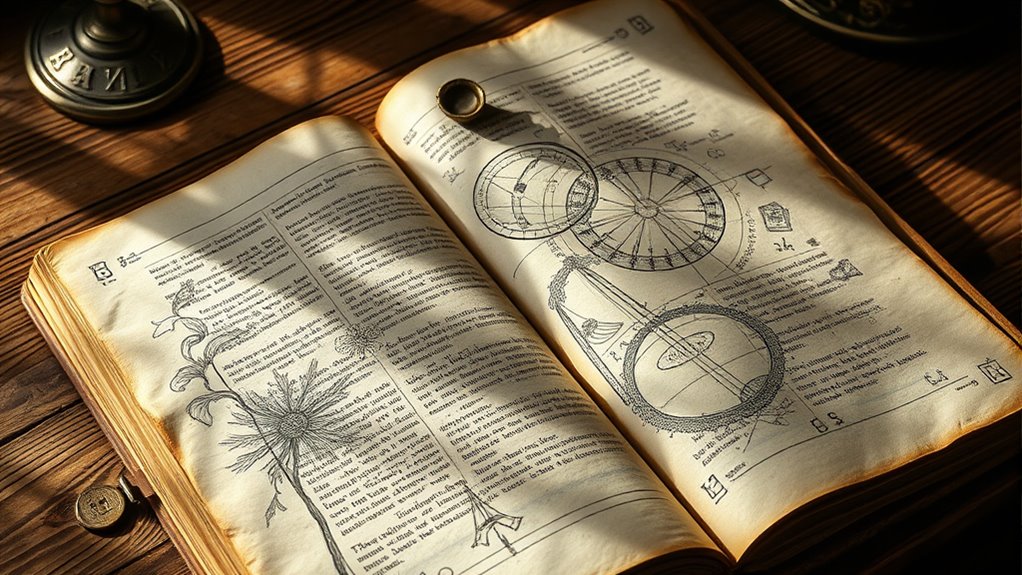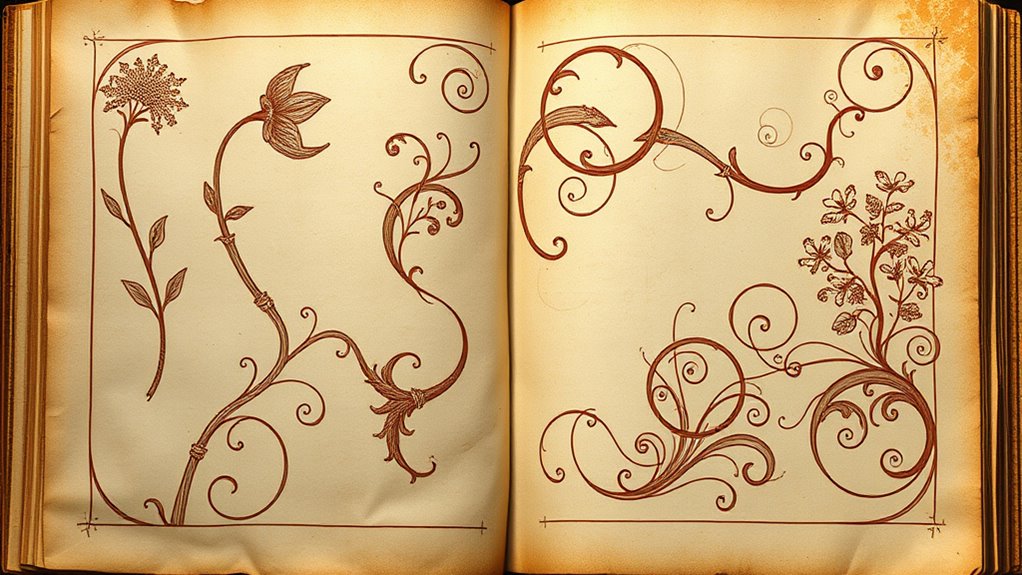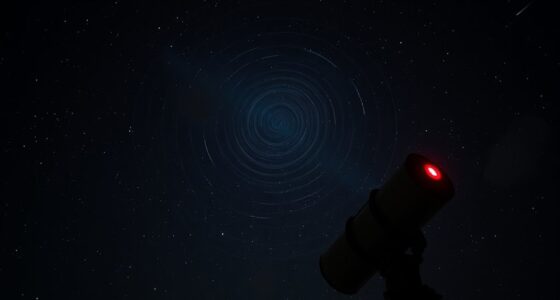The Voynich Manuscript remains one of the most mysterious books ever discovered, full of strange symbols and incomprehensible illustrations. Despite many attempts, no one has cracked its code or fully understood its purpose. It features bizarre plants, unusual writing patterns, and possible hidden meanings that could reveal secret knowledge. If you keep exploring, you’ll find more clues about its enigmatic origins and the ongoing efforts to decode this intriguing puzzle.
Key Takeaways
- Despite numerous attempts, the Voynich Manuscript’s symbols and language remain undeciphered, preserving its mystery.
- Researchers analyze its unique patterns, illustrations, and hidden details to uncover potential meanings or code structures.
- The botanical images suggest symbolic or coded representations, possibly linked to secret knowledge or alchemy.
- Various theories propose it’s a herbal guide, an elaborate hoax, or an encoded language from an ancient dialect.
- Ongoing research and advanced imaging techniques continue to seek clues, aiming to decode its enigmatic content.

Have you ever wondered what secrets lie within a mysterious, undeciphered manuscript? The Voynich Manuscript has puzzled scholars, linguists, and cryptographers for centuries, remaining an enigma wrapped in layers of cryptic symbols and strange illustrations. Its pages are filled with a symbolic language that defies all known ciphers, making it one of the most perplexing texts in history. You might find yourself captivated by the vibrant herbal illustrations, which seem to depict plants that don’t match any known species, yet they form an integral part of the manuscript’s mysterious narrative. These botanical drawings are not just decorative; they seem to serve a purpose within the text, perhaps as symbols or keys to understanding the language’s structure.
The Voynich Manuscript’s mysterious symbols and strange botanical illustrations continue to baffle scholars and enthusiasts alike.
The symbolic language used in the Voynich Manuscript is unlike any other. Instead of familiar alphabets or scripts, it employs a series of characters that repeat and combine in seemingly deliberate patterns. Researchers have debated whether it’s an encoded language, an elaborate hoax, or an entirely invented script. Some believe the symbols represent an unknown language that might be related to an ancient dialect, while others think it could be a sophisticated form of coded imagery. Despite numerous attempts, no one has cracked the code, and the true meaning behind these symbols remains elusive. This language’s complexity hints that it might encode knowledge or ideas that the author wished to keep hidden, or perhaps it served as a form of artistic expression.
Meanwhile, the herbal illustrations add another layer to the mystery. These drawings suggest the manuscript could be a herbal compendium, but the plants depicted don’t match any known flora. Their strange shapes and unfamiliar features make you wonder if they’re real plants or entirely imaginary creations. Some theorists argue they could be symbolic representations of concepts like health, spirituality, or alchemy, rather than actual botanical specimens. The combination of these unusual plants with the symbolic language points towards a system of knowledge that’s both visual and written, designed perhaps to communicate secret medicinal or mystical practices. Interestingly, modern imaging techniques have revealed hidden details within the illustrations that may offer further clues to their meaning.
In trying to decode the Voynich Manuscript, you’re not just deciphering strange symbols—you’re attempting to understand a complex system of communication that blends imagery and language in a way no other text does. Its herbal illustrations aren’t mere decoration; they hold clues that might disclose the manuscript’s hidden meaning. Yet, with every new discovery, the mystery deepens, and you’re left pondering whether this is a genuine record of forgotten knowledge or an elaborate hoax. The voyage to decode it continues, and the allure of its secrets remains irresistible.
Frequently Asked Questions
Has Anyone Ever Successfully Deciphered the Manuscript’S Language?
You wonder if anyone’s successfully deciphered the manuscript’s language. Despite extensive cryptogram analysis and numerous linguistic attempts, no one has definitively cracked its code. Researchers have proposed theories, but the text remains largely a mystery. You’d need to contemplate the unique script and unknown language, which make it incredibly difficult. So, as of now, the manuscript’s language remains undeciphered, keeping its secrets well hidden.
What Are the Leading Theories About the Manuscript’S Purpose?
You might wonder about the manuscript’s purpose, and experts suggest it could be a blend of medieval symbolism and cryptographic puzzles. Some believe it served as a herbal or alchemical guide, while others think it was a sophisticated hoax. Theories also propose it was meant for secret communication or mystical teachings. Its mysterious illustrations and coded text continue to fuel debates about whether it was practical, spiritual, or simply an elaborate riddle.
Could the Manuscript Be a Sophisticated Hoax or Forgery?
You wonder if the manuscript is a sophisticated hoax or forgery. The authenticity debate continues, fueled by limited forgery evidence and complex cryptography. Some argue it’s a clever fake designed to deceive, while others believe it’s an authentic, mysterious document. You should examine the handwriting, ink, and materials, as these clues can reveal whether it’s a masterful forgery or a genuine, enigmatic artifact worth unraveling.
How Does the Manuscript Compare to Other Historical Coded Texts?
You find that compared to other historical coded texts, the Voynich Manuscript uses unique cryptographic methods that are more complex and less understood. Its historical context suggests it may have been designed to obscure meaning intentionally, unlike simpler ciphers seen elsewhere. You notice that while other texts often follow known encoding patterns, this manuscript’s mysterious symbols and unusual structure set it apart, making it a fascinating cryptographic puzzle.
What Modern Technologies Are Being Used to Analyze the Manuscript?
Did you know that over 90% of ancient texts are now analyzed with modern tech? Today, researchers use spectral imaging to reveal hidden details, like faded writing or illustrations, while machine learning helps identify patterns and possible languages. These tools allow you to uncover clues that were previously invisible, bringing new insights into mysterious documents. With these advances, decoding complex texts becomes faster and more accurate, pushing the boundaries of historical discovery.
Conclusion
Deciphering the Voynich Manuscript remains a tantalizing puzzle. Imagine discovering a hidden message buried within its strange symbols, just like a historian once thought they found a code revealing lost knowledge. You realize that solving it could unseal secrets of ancient cultures or reveal new languages. This mystery challenges you to think beyond conventional limits, reminding you that some questions are worth pursuing, even when answers seem forever out of reach.









